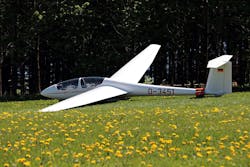DARPA’s latest pursuit? Stealth gliders that dissolve when exposed to sunlight
WASHINGTON - Imagine the following scenario: there’s a mission in which spies or soldiers must cross over into enemy territory without raising any alarms. Due to the terrain, the approach that’s been decided on involves parachuting or gliding in under cover of darkness. But once said troops have been deposited, how do you get rid of the evidence of their arrival? Carrying a human-sized glider, or even a full-sized parachute, is prohibitive. It’s also a stretch to assume that there will be some easy way of disposing of the equipment by, say, burying it underground or at the bottom of a nearby body of water, writes Luke Dormehl for DigitalTrends.com. Continue reading original article
The Intelligent Aerospace take:
August 29, 2019-“This is for applications where you do not want to leave the product behind,” Paul Kohl, Regents’ Professor in the School of Chemical and Biomolecular Engineering at Georgia Tech, told Digital Trends. “Maybe there is too much [to carry], such as a bunch of parachutes. Maybe you don’t want someone to discover the product. Maybe you do not want someone to [be able to reverse-engineer it].”
Kohl presented his team's work at a meeting of the American Chemical Society in California this week. Kohl's team created a polymer derived aldehyde that is photosensitive and will depolymerize when exposed to ultraviolet light. The material, which could be used for a glider or parachute, will disappear when the sun rises, or earlier, with a small light emitting diode.
There is plenty more work to be done before a disappearing aircraft comes to fruition, though, as Kohl's team made a prototype that could only carry a one kilogram payload, which is a bit lighter than a squad of warfighters or a single person.
Related: Raytheon, DARPA complete key design review for new hypersonic weapon
Related: DARPA funding brings machine learning to BAE Systems’ Signals Intelligence capabilities
Jamie Whitney, Associate Editor
Intelligent Aerospace
